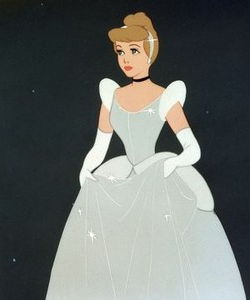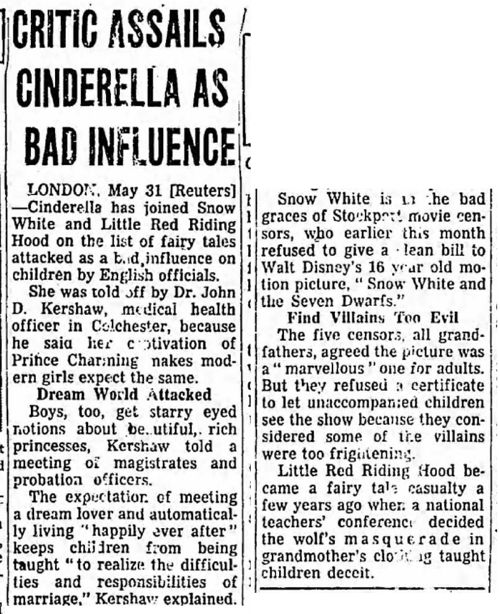Cinderella’s Bad Influence

In the 1950s, Dr. John Kershaw, an English medical officer, argued that, "The expectation of meeting a dream lover and automatically living 'happily ever after' keeps children from being taught 'to realize the difficulties and responsibilities of marriage.'"
More recently, Cinderella has been attacked for the "princess culture" that it cultivates. From the Sentinel & Enterprise (3/22/2012):
Assistant English professor Joe Moser said he believes Disney's "Cinderella" is a patriarchal, cautionary tale warning American women against being too independent. Released in 1950, the movie came shortly after World War II, a time when many women took jobs outside the home because the men were away. Moser thinks some of the aspects of the film were a push to put women back into their supposed place.
"Cinderella is remarkably passive throughout the entire movie," Moser said, adding that Prince Charming didn't take much of his life into his own hands either and relied greatly on his father.
Rather than make her own dreams come true, he said, Cinderella waits for others, such as her fairy godmother, to do the work for her, and trusts that things will turn out right.
The message it sends is that it is best to buy into the status quo and that one's dreams can be achieved by following the rules set by previous generations, Moser said.
"Cinderella is remarkably passive throughout the entire movie," Moser said, adding that Prince Charming didn't take much of his life into his own hands either and relied greatly on his father.
Rather than make her own dreams come true, he said, Cinderella waits for others, such as her fairy godmother, to do the work for her, and trusts that things will turn out right.
The message it sends is that it is best to buy into the status quo and that one's dreams can be achieved by following the rules set by previous generations, Moser said.
NY Times critic Peggy Orenstein has even written a bestselling book on this subject, Cinderella Ate My Daughter (2011).
To the best of my knowledge, I've never seen Cinderella. Perhaps I should consider myself lucky for having escaped its poisonous influence.

Chicago Daily Tribune - June 1, 1954
Comments
Cinderella slept in the coal bin, worked hard while her stepsisters played, and dressed in rags.
Now she lives in a magnificent palace, has an army of servants at her beck and call, and has thousands of elegant gowns.
This proves that the right pair of shoes will change your life.
Now she lives in a magnificent palace, has an army of servants at her beck and call, and has thousands of elegant gowns.
This proves that the right pair of shoes will change your life.
Posted by Phideaux on 01/04/17 at 10:46 AM
Oh yeah, just as Donald Duck has influenced me to walk around in public without any pants. Seriously, where do people get these notions?
Posted by KDP on 01/04/17 at 03:10 PM
It seems to me that we need Fluffy Bunny Slippers to come in on this shoe question. I wonder where ze is when we need hir.
Posted by Virtual on 01/05/17 at 06:00 PM
You cannot pick a medieval tale, show it in the 1950 and expect it to be feminist and empowering. Now, if you take today's Belle and the Beast... that's scandalously machist. When will we see the tale about the tower builder and his neighboring lord whose child get swapped by a distracted midwife? The lord's daughter was much more empowered in this one (and the builder's son was a happy moron, just like Cinderella).
Posted by Yudith on 01/08/17 at 07:10 AM
Commenting is not available in this channel entry.

Category: Movies | Myths and Fairytales | 1950s